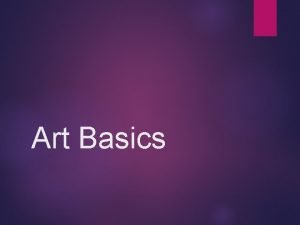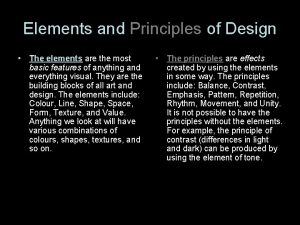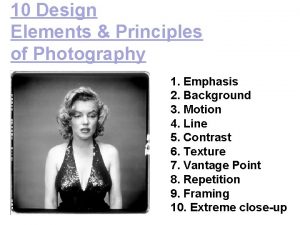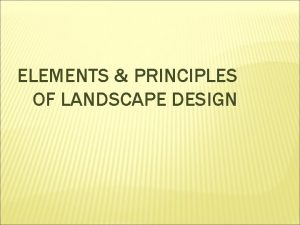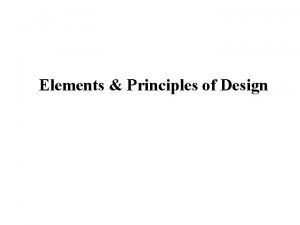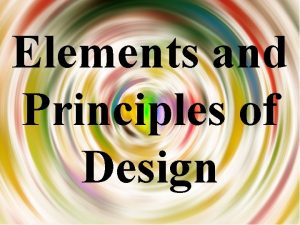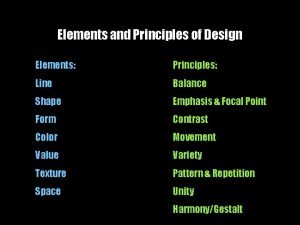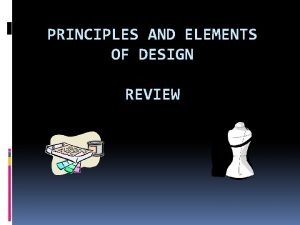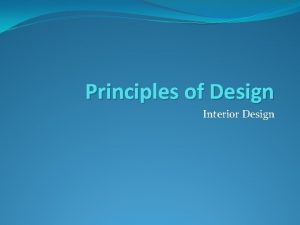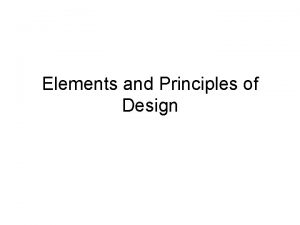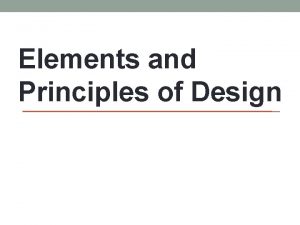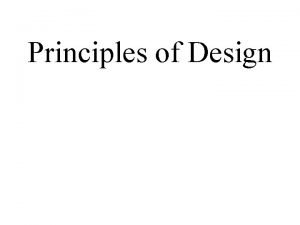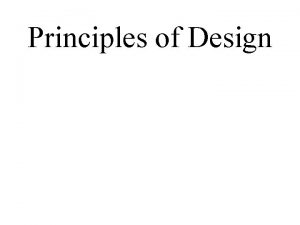Elements and Principles of Design The elements are















- Slides: 15

Elements and Principles of Design • The elements are the most basic features of anything and everything visual. They are the building blocks of all art and design. The elements include: Colour, Line, Shape, Space, Form, Texture, and Value. Anything we look at will have various combinations of colours, shapes, textures, and so on. • The principles are effects created by using the elements in some way. The principles include: Balance, Contrast, Emphasis, Pattern, Repetition, Rhythm, Movement, and Unity. It is not possible to have the principles without the elements. For example, the principle of contrast (differences in light and dark) can be produced by using the element of tone.

Line is the path of a moving dot. There are many different kinds of lines: straight - curved, jagged smooth, thick - thin, weak - strong, dark - light, long - short, wavy feathery, actual - implied. Many different materials and tools can make lines. Lines can be vertical, horizontal, or diagonal, and can change direction abruptly forming a corner, or change direction gently, forming a curve. Lines can express mood and emotion. Lines can be used to divide space, define shapes, create tonal values and show volume, simulate texture. Stripe Song J. Seeley Lines of varied thickness and direction create an illusion of volume in this piece.

Shape When a line begins and ends at the same point, a shape is made. All shapes have two dimensions - length and width. Shapes can be geometric, such as circle, oval, square, rectangle, or triangle OR shapes can be 'organic', free form. Zapatistas Jose Clemente Orozco Note the prominent shapes of the figures and the sombreros. Shapes can be representational something you can recognize, or shapes can be non-representational a non-recognizable shape. Shapes can be positive or negative.

Texture refers to the feel or look of a surface. All surfaces have texture. There are many different kinds of surface textures including: rough, smooth, prickly, soft, coarse, furry, pebbly, shiny, gritty, velvety. Actual texture is the surface texture that can be seen and felt. Simulated or implied texture is drawn or painting to created the illusion of texture. It cannot be felt, only seen. Texture will affect light reflection and causes colour values to change. Texture creates highlights and shadows. Ecriture No. 931215 Seo-Bo Park Artwork can have actual textures or the illusion of textures.

The Elements: Colours/hues are the names given to the different rays of light that are visible in a spectrum, for example, the light refracted through a prism. Colours can give the illusion of depth: closer objects are more intense, while distant objects appear duller. Turning Road L'estaque Andre Derain was part of an art movement called the "Fauves" (wild beasts). These artists were known for their use of bright primary and secondary colours. The effect of a colour can be changed by the surrounding colour. Colour is the most persuasive element. Colour can show emotions and mood. Colours can be put into groups of warm and cool colours.

Form When the third dimension of depth (or thickness) is added to length and width, shape becomes form. Form can be geometric such as cube, cylinder, cone, or sphere, or shape can be organic, free form. Form can be representational - something you can recognize, or shapes can be non-representational a non-recognizable form. Form can be actual 3 -D, or implied 3 -D Bronze Vessel China The illusion of 3 -D form can be represented on a 2 -D surface, for example, in a drawing through the use of tonal work such as shading.

Space can be the actual three dimensional features of a sculpture in space, or the illusion of space and depth created in a two dimensional image. Illusion of space on a two dimensional (2 -D) surface can be achieved through a number of natural perspective means, including: relative apparent size, overlapping, placement on the picture plane, colour intensity variation, use of lights and darks, use of warm or cool colours, and amount of distinction and detail. Illusion of space can also be achieved through linear perspective, a concept where three dimensional forms are drawn on a two dimensional surface using a system of parallel converging lines that come together at a point, known as a 'vanishing point'. Positive space is that which is occupied by forms. Negative space is that which is unoccupied, or empty space. An artist may choose to present space in a realistic sense in the image or may distort or eliminate space to create an effect. New City Gene Bodio A strong sense of space is achieved using linear perspective.

Value All objects are defined by the way light touches their surfaces. Light, or the lack of it -dark, are chiefly responsible for the definition of form. A colour can be darkened by adding black, resulting in shades of that colour. A colour can be lightened by adding white, resulting in tints of that colour. Artists use bold contrasts of value in order to express powerful effects in an image. Clearing Winter Storm Ansel Adams Note the full range of tones from white through to black. Value can help express space - distant objects are dull, while closer objects are brighter. Usually, dark values appear to come forward and light values tend to recede.

The Principles: Balance Chilkat Blanket Tlingit The design of this blanket is symmetrically balanced. There is balance when the parts of an image have the same visual weight Imbalance can create a sense of awkwardness or discomfort, and can be used to create tension or impact in an image. Balance can be symmetrical (formal) in which the parts are visually equal, such as two shapes of the same size. Symmetrical balance gives a sense of order, and stateliness. Asymmetrical (informal) balance may have parts that a re not identical, such as two small shapes balanced by one large shape. Asymmetrical balance gives the sense of activity and creates interest. Radial balance revolves around a real or imaginary central point.

Emphasis Blue Lights and Rockets JMW Turner Swirling atmosphere, strong lines, contrasts, and reflections, all draw attention to the bright focal point. Emphasis is used to call attention to a specific area in an image. Emphasis is sometimes also referred to as the focal point or center of interest. Emphasis can be achieved by: increased size, strong colour, greater detail, sharp contrast, distorted shape, placement in the composition, movement of the image leading the eye to a focal point.

Contrast is created when two unlike qualities are placed together. Contrast can be achieved through the use of any of the elements. Contrast can be used to emphasize, dramatize, surprise or add variety to an image. Contrast can be high or low (strong or subtle). High contrast tends towards a more dramatic effect, while low contrast tends towards soothing and settling. David and Goliath Caravaggio This painting displays an extreme form of contrast called 'chiaroscuro' which emphasizes sharp differences in light and dark for a dramatic effect.

Pattern is created by the repetition of an element or similar elements. Pattern can be organized or random. Repeated pattern can create rhythm. The repetition within pattern can be regular or irregular. Sienna Plate with feather design Maria Martinez

Rhythm, a vital and natural part of our universe, is created in an image through the repetition of certain components. Rhythm A progressive continuity of the rhythm can be created by increasing or decreasing the elements in a series, such as smaller to larger, lighter to darker, rougher to smoother, etc. The repetition can be regular or irregular. Regular repetition results in a formal rhythm. The natural environment provides many examples of precise repetition. Repetition with variation is often more interesting. Repetition can have other effects in an image, for example, a colour repeated in different areas of a picture can increase its power. Eiso Paul Manes Repetition of certain elements within an image Repetition of the oval, cup shapes creates a tends to hold the overall design together. visual rhythm.

Unity in an image is achieved when the elements work together to produce harmony, completeness, and a sense of order. Unity can be achieved though various elements, such as in the combination of similar colours, lines, shapes, etc. Lack of unity produces disharmony, incompleteness, disorder, and dissonance. Canyon Wall 14 Virginia Cobb Similar shapes and colours, and a gridbased composition establish unity in this painting. However, unity without contrast can be uninteresting.

Movement Trio Steve Magada Repeated, gestural lines create a sense of movement. Movement is meant to show activity in an image. Movement is achieved by manipulating the element, such as the use of tonal gradation, repeated lines, etc. Stop action' images such as sports activities, show physical movement. Compositional movement can also use lines or repeated colours or patterns to lead the viewer's eye from place to place within the image.
 Insidan region jh
Insidan region jh What are the 5 principles of hair design
What are the 5 principles of hair design Wave pattern hair
Wave pattern hair Proximity floral design
Proximity floral design Elements and principles of design chart
Elements and principles of design chart Interior design lecture notes+ppt
Interior design lecture notes+ppt Elements and principles design matrix
Elements and principles design matrix Art basics
Art basics Ci element
Ci element Steve magada trio
Steve magada trio Stresses movement makes the viewer feel alive in the moment
Stresses movement makes the viewer feel alive in the moment Gradated rhythm
Gradated rhythm Elements and principles of landscape design
Elements and principles of landscape design What are the elements and principles of design
What are the elements and principles of design Christina's world
Christina's world Visual elements and principles of design
Visual elements and principles of design







